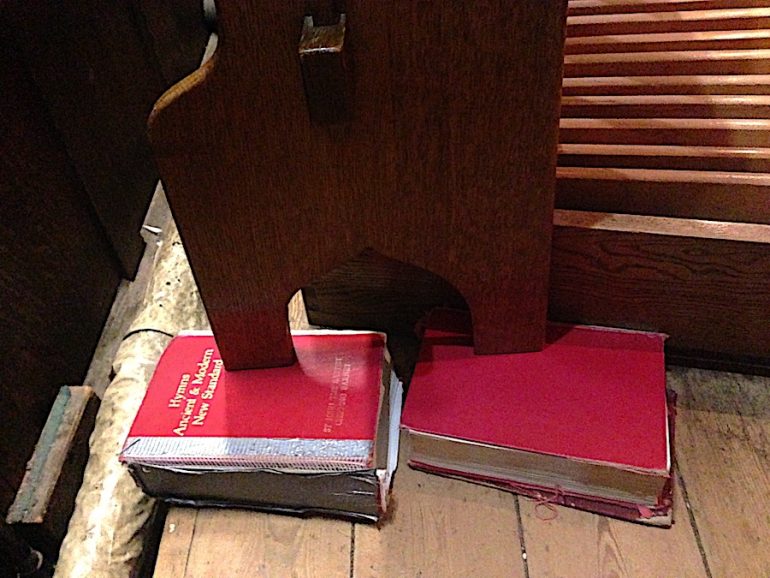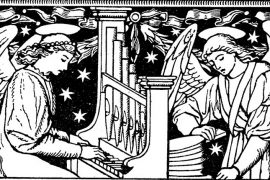Anything about pedalling is always popular here, and a reader’s questions has provoked another article. I’ve taken as authorities the writings of a number of recognised organ teachers, from the 19th century to the present day – see end for details.
Playing in socks?
Is it possible to have a good technique without wearing shoes? was Mervyn’s first question. I’ve been told that some top organists play in socks (well I’ve heard of ONE top organist who plays in socks) but all my authorities insist on shoes. Jonathan Bunney compares playing without shoes as ‘trying to play tennis without a decent racket.’ The expression ‘to provide support’ is often used – though to my mind this requires explanation, which is not always forthcoming. However both Stainer and Dickinson provide a convincing rationale of the need for shoes, when describing suitable soles:
‘…too heavy shoes are unwieldy and interfere with the sensitiveness of the foot, while soles that are too thin are apt to overtire the more delicate foot muscles.’ (Dickinson)
‘…if they are too thin, many delicate muscles of the foot will be called into play whose co-operation is totally unnecessary in pedalling, but whose use will cause great fatigue (his emphasis) to the hard-working student.’ (Stainer)
So save playing in socks for those self-indulgent moments – it’s a struggle in the long run, and the moment we leave the baroque and heels become involved then the unshod foot is at a disadvantage, particularly if you are short.
If you do wear them, what are the ideal shoes?
Although famously Dupré, when asked what shoes he played the organ in, answered, rather puzzled, ‘Why, my own!’, most authorities recommend setting aside a pair of shoes just for organ playing. It’s bad manners to rub street grit and grime over a unique instrument for one thing. A slightly worn leather sole, says Sanger, gives the right kind of grip – rubber or composition soles not sliding easily enough. The advice I got before an RCO course several years ago sums up the general thinking:
Leather soles
No extended seam around the outside of the shoe
A steel shank (that is, a supported shoe, not slippers or ‘jazz’ shoes)
A non-tapered heel (that is, not a wedge, Cuban or graded heel) with a height of at least 1.5 inches/approx 4 cm.
Tapered heels are not good, says Anne Marsden Thomas, because they reduce the span between the contact points at toe and heel – so the interval you can play between toe and heel is reduced. Stainer adds for the benefit of late 19th century women organists ‘Lady-pupils should avoid very small and also very circular heel-pieces, unless indeed they are prepared to undergo a temporary imprisonment or purchase liberty by the sacrifice of a boot.’ So no kitten heels, girls, then or now.
Much of the advice on heel height probably relates to women’s organ shoes rather than men – a higher heel usefully extends the reach of the legs, says Anne Marsden Thomas, and David Sanger suggest ‘a slightly deeper heel than usual can make for more comfortable pedal-playing’. Joyce Jones adds that shoes should tie or buckle, rather than being slip-on, unless they are very close fitting. She mentions tap dancing shoes (without the taps, obviously) or folk dancing shoes as possibilities.
I’ve noticed Anne Marsden-Thomas plays in some rather elegant strappy items, but if you want to emulate your favourite female recitalist with something soigné and sparkly then US organists seem to have rather more options, sigh. My own organ shoes are some sensible black Mary-Janes from US company Organmaster Shoes (currently available in the UK through Church Organ World) and I had the heels built up from 3cm to 4cm (I’m 5 foot 2 inches) by a local cobbler, reminding him to finish them with a leather base, not a conventional rubber heel.
Correct seat height and position?
Dickinson is quite specific about this : ‘The bench must be the right height, which is twenty inches from the top of middle D on the pedal keyboard to the top of the organ seat. The high bench is responsible for much poor organ playing, as the player is obliged to sit on the edge of the seat instead of being able to maintain the perfect balance possible only when he is seated squarely and solidly in the middle.’
Jacques Oortmerssen, the great authority of the late 20th century on organ technique for early music, says nothing about shoes in his book, but really gets into his stride on habitus, or the organist’s posture, where he contradicts Dickinson. I can’t do Oortmerssen full justice here, so you will just have to get hold of the book (although the assumption that you read four European languages so fluently that the extensive quotes are in no need of translation is rather irritating). His main point is ‘To achieve maximum freedom it is important that the area of contact between the body and bench is as small as possible. One must not sit on the bench but in a manner of speaking, against it.’ He quotes Tournemire recommending ‘…sit on the edge of the bench, with body leant forward, somewhat as while cycling…’
Anne Marsden Thomas takes a middle line, saying ‘Sit as far forward on the bench as is comfortable, so you feel lightly supported by the bench while your legs experience maximum freedom,’ which seems rather more realistic.
Stainer says the test of a good position is ‘When seated, lift up both feet and hold them just over the pedals so that they could play either the long or short keys, at the same time holding both hands over the manuals. If you have an uncomfortable sensation that you are likely to knock your nose against the desk, the organ stool is too far way from the keys or you are sitting too near its edge. If you cannot move your knees freely to the right and left the stool is either too near the keys or you are sitting too far on it.’
The relationship between organist, bench, pedals and manuals is often going to be imperfect – yet another issue we have to stay calm about. Small people complain about not being able to reach the pedals, but I’m told having your legs crunched up against the underside of the manuals is much, much worse. Sanger: ‘…wooden blocks (or perhaps some old hymn-books) may be placed under the bench to raise it to a suitable height. Unfortunately no such easy remedy can be applied if the stool is too high!’ sums it up nicely.
How important is core strength to all of this?
‘Good posture’ is always recommended, along with ‘relaxation’. Yeah, but how? The default organist position is usually head poked forward, squinting at the ill-lit music, developing into something approaching a foetal crouch as that bit you can’t really play approaches.
‘The aim of technique could be defined as follows: the prevention of, or reduction in, tension during physical effort,’ says Oortmeerson, and Dickinson quotes Forkel, describing Bach’s playing, who, after telling how the great master used his hands and feet, adds, ‘The other parts of his body took no part in the performance.’
‘Sitting is an activity,’ says Oortmerssen – rather than a passive slump – and I take his point. One could probably get closer to Oortmerssen and Bach the more core stability you have. So to answer Mervyn’s final question: regular gym visits, Alexander Technique, yoga, pilates – frankly anything that makes us more body aware – must be helpful. All that’s required is someone prodding and poking us back into shape while we play the wretched instrument, for several months, until our bodies understand what is required.
Your comments please!
I’d be particularly interested to hear from people who’ve studied the organ outside the English/US schools of organ playing. Comment box below, or email me.
WORKS CONSULTED:
ORGAN TECHNIQUE, Jacques van Oortmerssen, Goteborg Organ Art Centre, 2002
PEDAL MASTERY FOR ORGAN, Joyce Jones, Alfred Publishing Co, Inc, 1979
COMPLETE ORGAN METHOD, A Classic Text on Organ Technique, John Stainer, Dover Publications, 2003 (a reprint of THE ORGAN, J Stainer, Novello’s Music Primers, first published in 1877)
PEDALLING FOR ORGANISTS, Anne Marsden Thomas, Cramer, 2014
PLAY THE ORGAN Volume Two, David Sanger, Novello, 1993
THE TECHNIQUE & ART OF ORGAN PLAYING, Clarence Dickinson, H W Gray Publications, 1922
PEDALLING (video), Jonathan Bunney, on iRCO, the virtual campus of the Royal College of Organists (free to RCO Members, small charge to non-Members, (free) logon required)
My previous posts on pedalling are summarised here.






I’ve been pointed in the direction of Pascale Melis playing Bach in some rather serious stilettos on YouTube!
https://www.youtube.com/watch?reload=9&v=P_04cAXL_tk&feature=youtu.be
Very nice how she plays Bach on a French romantic organ. Cavaillé-Coll rocks !
Surprising to see her playing in high heels. Even though Bach does not require using heels.
Just wondering if she would play in high heels too on Romantic pieces.
A reader’s recommendation for a dance-shoe company with well-priced shoes that fit the general recommended description for organ shoes: https://www.supadance.com
Another possible dance-shoe company is of course Freed.
Thank you for this helpful and, for me, timely article. I am trying to resurrect some organ skills I had in the 70’s because our small chapel was gifted with an organ. Haven’t ordered my shoes yet, but I am leaning toward OrganMaster Mary Janes. Socks do not work for me at this time – my toes end up on either side of a pedal with sometimes comical (and occasionally painful) results!
Some time ago I set up my own organ at home. It became natural for me to play in socks, and now I’m not able to play in shoes. My feet in shoes becomes literally blind. Yes. This habit can sometimes be embarrassing, especially that in some churches the pedalboard is not the cleanest, The second embarrassing thing is disbelief and embarrassment in the eyes of some peoples when I take off my shoes when sitting at organ bench. It is as if they expected me to take my trousers off … But returning to the habits. Whole my life I played organ in shoes and it seemed to me that it was impossible to play well in socks. Everything changed when I started to practice at home and I did not want to wear shoes just for it. Yes I’m lazy. For this reason I think that all this is a matter of habit. By the way, I really like your entries, even if I sometimes disagree with them.
Thank you for this article. It confirms what I have learned by trial and error during almost 60 years of playing the organ. The details re: the appropriate height of the organ bench was helpful new information for me …. but it makes perfect sense as I consider the various organs I have played. Most of them have not created a balance problem for me, i.e. I could reach all the pedals without constantly slipping forward off the bench. That is what happens when I am seated on the bench of the organ that I am currently using, located at my church. Since the others who play the organ are a bit taller than I am and have no problem with the bench height, I use a small piece of rug and a softly rubberized backing on it to keep me from falling off the bench when using both feet simultaneously. It isn’t perfect, but it works.
I’ve always used leather shoes with a leather sole. On rare occasion when my organ shoes weren’t available, I’ve used socks, but find it more difficult to fit my toes between the “black” keys without the gently rounded toe of a shoe. I also find it more difficult to perform toe, heel, toe functions when in socks. I started playing the organ with a normal flat heeled shoe, but found I was better able to reach the pedals when I got a pair of shoes from The American Guild of Organists …. such as the “Mary Jane” shoes mentioned in the article. That’s all I’ve used since.
I did a similar thing on a very slippery bench when I played in North London – I sat on a piece of shammy leather (the sort they sell for polishing cars) to stop myself falling off the front. A very petite colleague used to carry round a rubber bath mat!! – and occasionally she left it behind, to the bafflement of the vergers and churchwardens who found it.
Very interesting!
I’ve recently discovered Camry organ shoes from https://www.tictactoes.com//dance/special_organist.htm. They are beautifully flexible and very comfortable. They come in 2 heights and lots of fun colours. Tic Tac Toes do other ladies organ shoes in various designs.